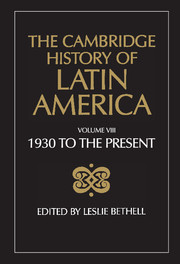9 - Bolivia since 1930
from PART THREE - PERU AND BOLIVIA
Published online by Cambridge University Press: 28 March 2008
Summary
The history of Bolivia could be viewed as the history of a rather small elite (or cluster of political, economic and bureaucratic elites) whose members were frequently on first-name terms with one another and whose alliances and divisions often had as much to do with private as with public life. Membership might be achieved through family background, education or success in one of a limited range of (essentially urban) careers, but the qualifications did not have to be particularly high to exclude the great majority of the population. Fluency in spoken and written Spanish, access to a town and a means of livelihood sufficiently secure to leave a margin above individual subsistence disqualified the great majority of adult males, at least until well into the second half of the twentieth century.
Nevertheless, the internal affairs of these elites could be highly complex and arouse great passion, and their divisions could have important consequences for the population as a whole (as in the Federal Revolution of 1898, when an armed conflict between Conservatives and Liberals – or perhaps between the elites of La Paz and Sucre – raised the peasant masses of the altiplano into collective action on a massive scale). The Bolivian elites were by no means homogeneous, or even coherent. The country's geography, the centripetal tendencies of its pattern of economic development (aptly symbolized by the external orientation of its railway system) and the colonial character of its social structure conspired against the emergence of a socially unified elite and contributed to the complexity and instability of its ‘traditional’ history.
- Type
- Chapter
- Information
- The Cambridge History of Latin America , pp. 509 - 584Publisher: Cambridge University PressPrint publication year: 1991
References
- 3
- Cited by

